Design Thinking Reflection Report - [University Name]
VerifiedAdded on 2022/09/28
|15
|3675
|22
Report
AI Summary
This report provides a comprehensive reflection on a student's learning experience in a Design Thinking for Managers course. The student details their journey, highlighting insights gained from blog writing and lecture classes, while also addressing the challenges encountered throughout the learning process. The report explores the relationship between design thinking and self-reflection, emphasizing the generation of new ideas and the importance of a beginner's mind. The student discusses specific lectures, including visualization techniques, the application of design thinking to business, and the use of brainstorming processes. The report further delves into the elements of design thinking, such as value chains and mind mapping, and the significance of empathy interviews and prototyping. The student identifies challenges faced, including the perceived linearity of design thinking and the difficulty in aligning lecture notes. The report concludes with an action plan to overcome these challenges, demonstrating a clear understanding of the design thinking framework and its practical application.
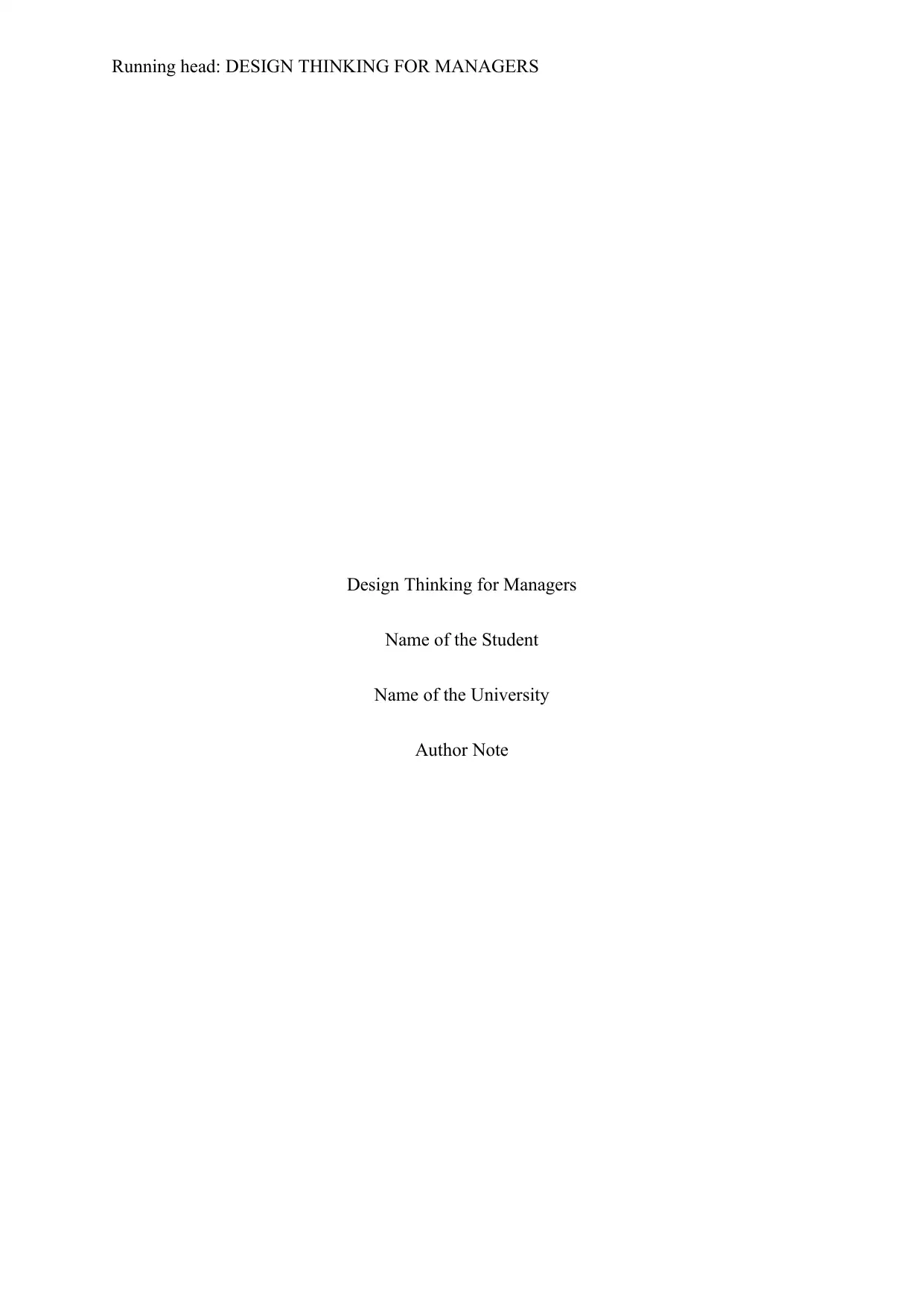
Running head: DESIGN THINKING FOR MANAGERS
Design Thinking for Managers
Name of the Student
Name of the University
Author Note
Design Thinking for Managers
Name of the Student
Name of the University
Author Note
Paraphrase This Document
Need a fresh take? Get an instant paraphrase of this document with our AI Paraphraser
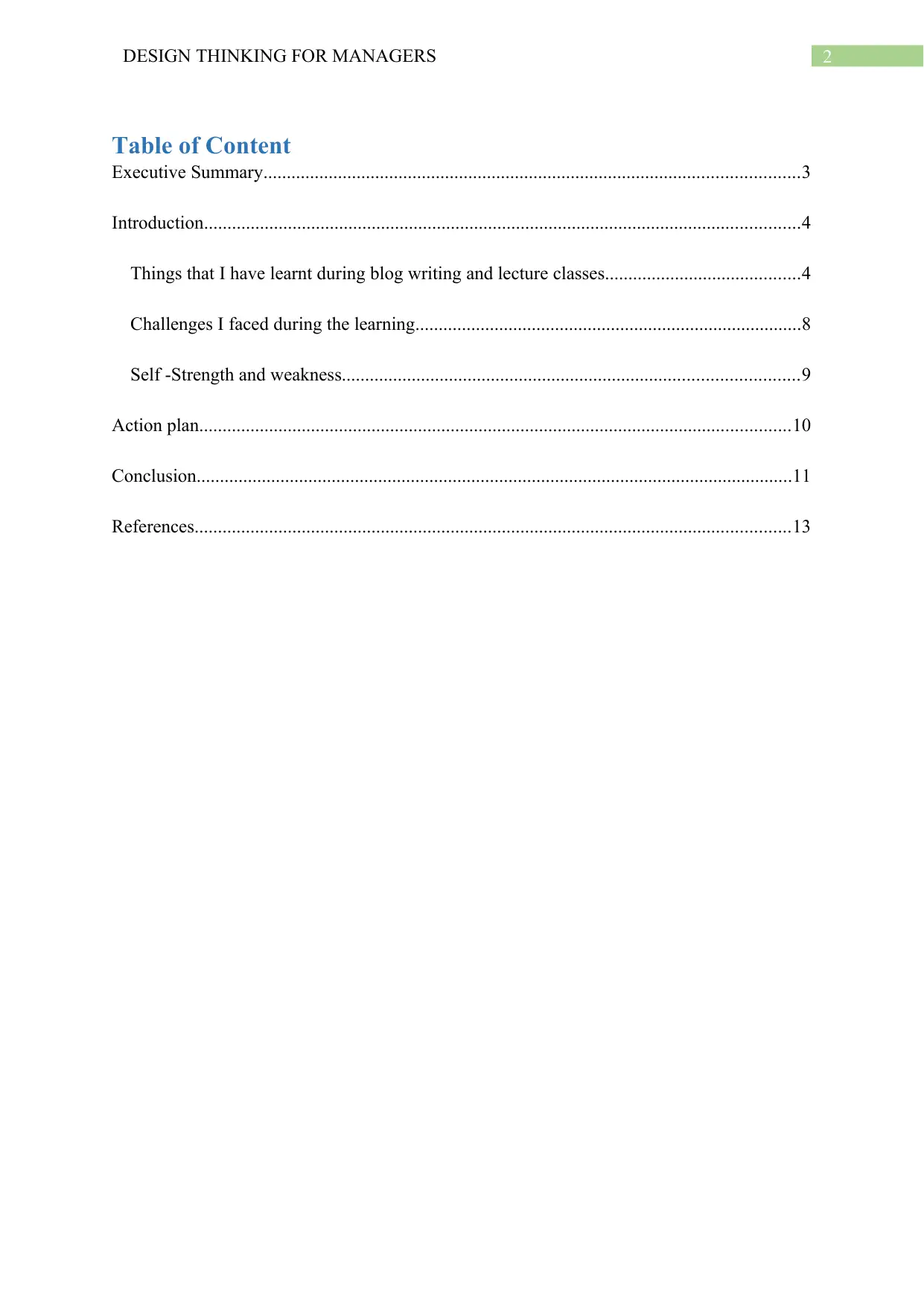
2DESIGN THINKING FOR MANAGERS
Table of Content
Executive Summary...................................................................................................................3
Introduction................................................................................................................................4
Things that I have learnt during blog writing and lecture classes..........................................4
Challenges I faced during the learning...................................................................................8
Self -Strength and weakness..................................................................................................9
Action plan...............................................................................................................................10
Conclusion................................................................................................................................11
References................................................................................................................................13
Table of Content
Executive Summary...................................................................................................................3
Introduction................................................................................................................................4
Things that I have learnt during blog writing and lecture classes..........................................4
Challenges I faced during the learning...................................................................................8
Self -Strength and weakness..................................................................................................9
Action plan...............................................................................................................................10
Conclusion................................................................................................................................11
References................................................................................................................................13
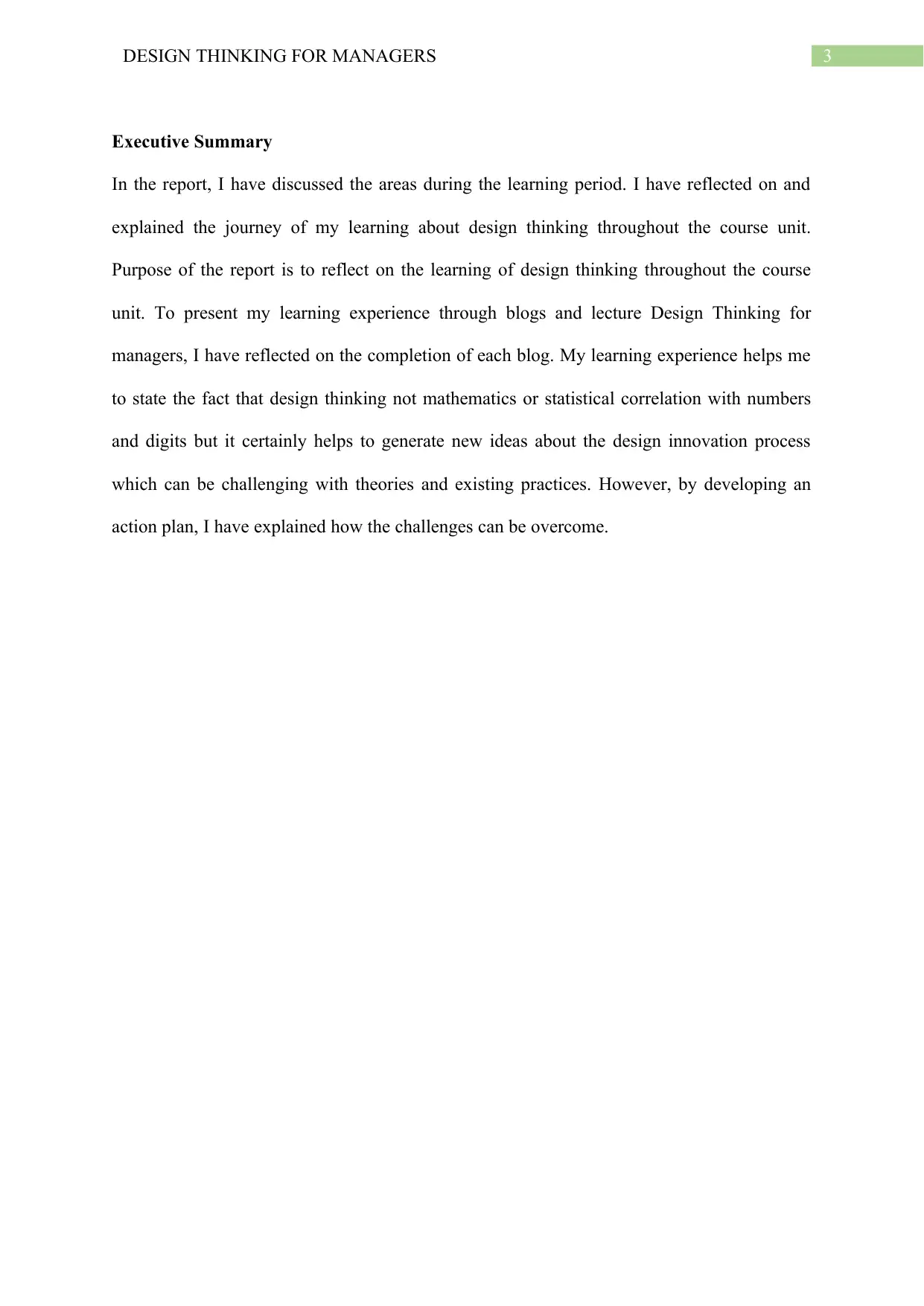
3DESIGN THINKING FOR MANAGERS
Executive Summary
In the report, I have discussed the areas during the learning period. I have reflected on and
explained the journey of my learning about design thinking throughout the course unit.
Purpose of the report is to reflect on the learning of design thinking throughout the course
unit. To present my learning experience through blogs and lecture Design Thinking for
managers, I have reflected on the completion of each blog. My learning experience helps me
to state the fact that design thinking not mathematics or statistical correlation with numbers
and digits but it certainly helps to generate new ideas about the design innovation process
which can be challenging with theories and existing practices. However, by developing an
action plan, I have explained how the challenges can be overcome.
Executive Summary
In the report, I have discussed the areas during the learning period. I have reflected on and
explained the journey of my learning about design thinking throughout the course unit.
Purpose of the report is to reflect on the learning of design thinking throughout the course
unit. To present my learning experience through blogs and lecture Design Thinking for
managers, I have reflected on the completion of each blog. My learning experience helps me
to state the fact that design thinking not mathematics or statistical correlation with numbers
and digits but it certainly helps to generate new ideas about the design innovation process
which can be challenging with theories and existing practices. However, by developing an
action plan, I have explained how the challenges can be overcome.
⊘ This is a preview!⊘
Do you want full access?
Subscribe today to unlock all pages.

Trusted by 1+ million students worldwide
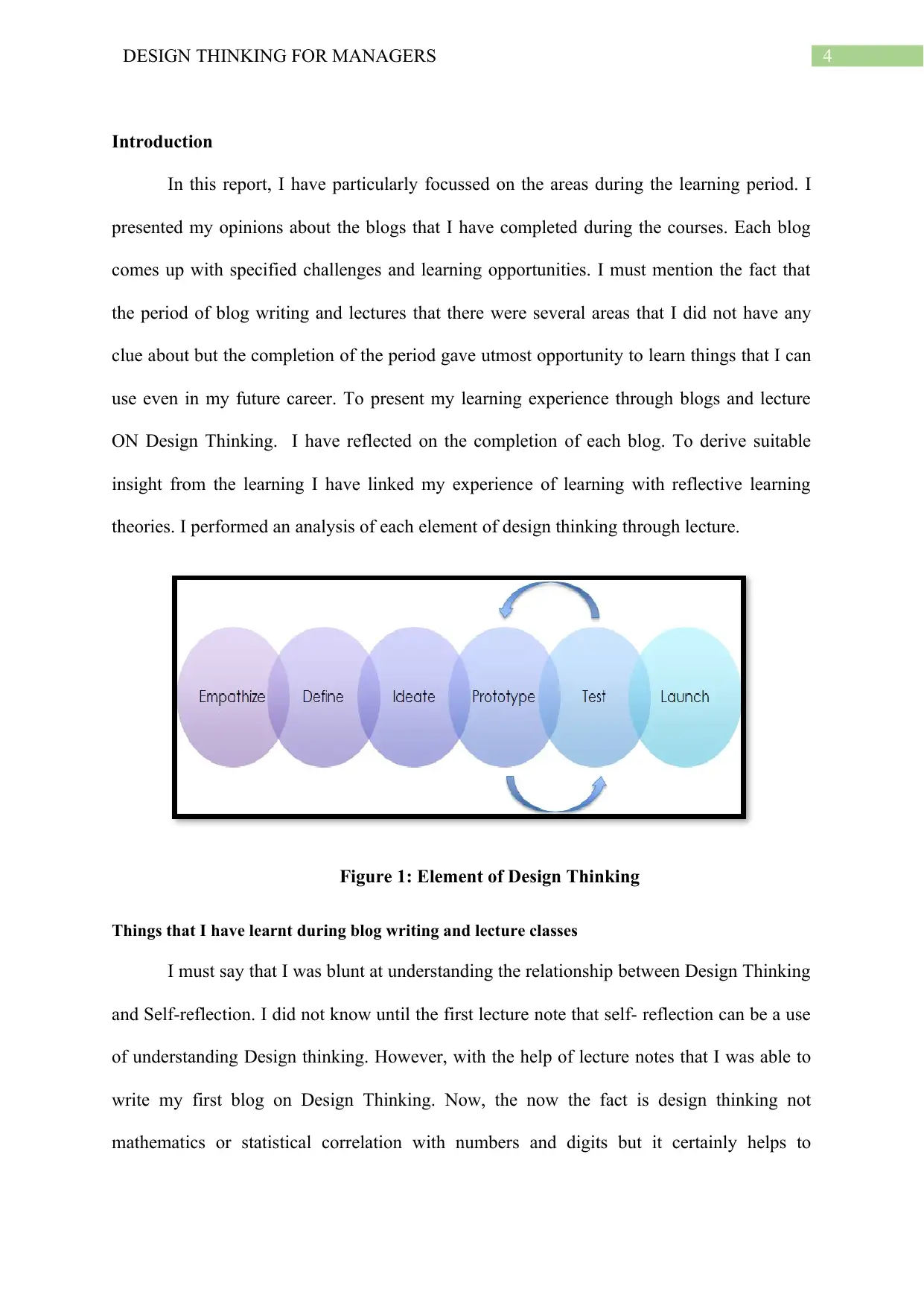
4DESIGN THINKING FOR MANAGERS
Introduction
In this report, I have particularly focussed on the areas during the learning period. I
presented my opinions about the blogs that I have completed during the courses. Each blog
comes up with specified challenges and learning opportunities. I must mention the fact that
the period of blog writing and lectures that there were several areas that I did not have any
clue about but the completion of the period gave utmost opportunity to learn things that I can
use even in my future career. To present my learning experience through blogs and lecture
ON Design Thinking. I have reflected on the completion of each blog. To derive suitable
insight from the learning I have linked my experience of learning with reflective learning
theories. I performed an analysis of each element of design thinking through lecture.
Figure 1: Element of Design Thinking
Things that I have learnt during blog writing and lecture classes
I must say that I was blunt at understanding the relationship between Design Thinking
and Self-reflection. I did not know until the first lecture note that self- reflection can be a use
of understanding Design thinking. However, with the help of lecture notes that I was able to
write my first blog on Design Thinking. Now, the now the fact is design thinking not
mathematics or statistical correlation with numbers and digits but it certainly helps to
Introduction
In this report, I have particularly focussed on the areas during the learning period. I
presented my opinions about the blogs that I have completed during the courses. Each blog
comes up with specified challenges and learning opportunities. I must mention the fact that
the period of blog writing and lectures that there were several areas that I did not have any
clue about but the completion of the period gave utmost opportunity to learn things that I can
use even in my future career. To present my learning experience through blogs and lecture
ON Design Thinking. I have reflected on the completion of each blog. To derive suitable
insight from the learning I have linked my experience of learning with reflective learning
theories. I performed an analysis of each element of design thinking through lecture.
Figure 1: Element of Design Thinking
Things that I have learnt during blog writing and lecture classes
I must say that I was blunt at understanding the relationship between Design Thinking
and Self-reflection. I did not know until the first lecture note that self- reflection can be a use
of understanding Design thinking. However, with the help of lecture notes that I was able to
write my first blog on Design Thinking. Now, the now the fact is design thinking not
mathematics or statistical correlation with numbers and digits but it certainly helps to
Paraphrase This Document
Need a fresh take? Get an instant paraphrase of this document with our AI Paraphraser
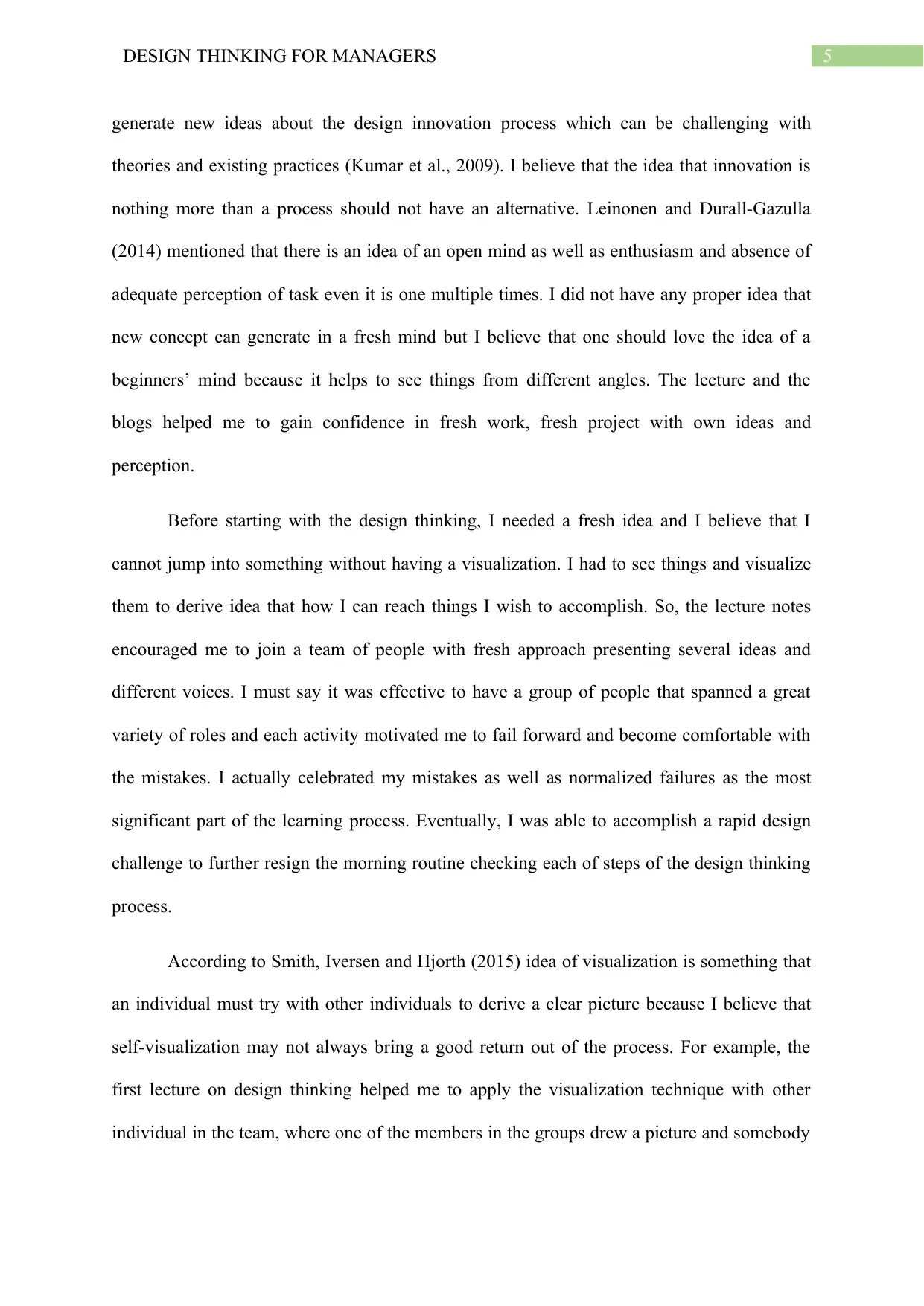
5DESIGN THINKING FOR MANAGERS
generate new ideas about the design innovation process which can be challenging with
theories and existing practices (Kumar et al., 2009). I believe that the idea that innovation is
nothing more than a process should not have an alternative. Leinonen and Durall-Gazulla
(2014) mentioned that there is an idea of an open mind as well as enthusiasm and absence of
adequate perception of task even it is one multiple times. I did not have any proper idea that
new concept can generate in a fresh mind but I believe that one should love the idea of a
beginners’ mind because it helps to see things from different angles. The lecture and the
blogs helped me to gain confidence in fresh work, fresh project with own ideas and
perception.
Before starting with the design thinking, I needed a fresh idea and I believe that I
cannot jump into something without having a visualization. I had to see things and visualize
them to derive idea that how I can reach things I wish to accomplish. So, the lecture notes
encouraged me to join a team of people with fresh approach presenting several ideas and
different voices. I must say it was effective to have a group of people that spanned a great
variety of roles and each activity motivated me to fail forward and become comfortable with
the mistakes. I actually celebrated my mistakes as well as normalized failures as the most
significant part of the learning process. Eventually, I was able to accomplish a rapid design
challenge to further resign the morning routine checking each of steps of the design thinking
process.
According to Smith, Iversen and Hjorth (2015) idea of visualization is something that
an individual must try with other individuals to derive a clear picture because I believe that
self-visualization may not always bring a good return out of the process. For example, the
first lecture on design thinking helped me to apply the visualization technique with other
individual in the team, where one of the members in the groups drew a picture and somebody
generate new ideas about the design innovation process which can be challenging with
theories and existing practices (Kumar et al., 2009). I believe that the idea that innovation is
nothing more than a process should not have an alternative. Leinonen and Durall-Gazulla
(2014) mentioned that there is an idea of an open mind as well as enthusiasm and absence of
adequate perception of task even it is one multiple times. I did not have any proper idea that
new concept can generate in a fresh mind but I believe that one should love the idea of a
beginners’ mind because it helps to see things from different angles. The lecture and the
blogs helped me to gain confidence in fresh work, fresh project with own ideas and
perception.
Before starting with the design thinking, I needed a fresh idea and I believe that I
cannot jump into something without having a visualization. I had to see things and visualize
them to derive idea that how I can reach things I wish to accomplish. So, the lecture notes
encouraged me to join a team of people with fresh approach presenting several ideas and
different voices. I must say it was effective to have a group of people that spanned a great
variety of roles and each activity motivated me to fail forward and become comfortable with
the mistakes. I actually celebrated my mistakes as well as normalized failures as the most
significant part of the learning process. Eventually, I was able to accomplish a rapid design
challenge to further resign the morning routine checking each of steps of the design thinking
process.
According to Smith, Iversen and Hjorth (2015) idea of visualization is something that
an individual must try with other individuals to derive a clear picture because I believe that
self-visualization may not always bring a good return out of the process. For example, the
first lecture on design thinking helped me to apply the visualization technique with other
individual in the team, where one of the members in the groups drew a picture and somebody
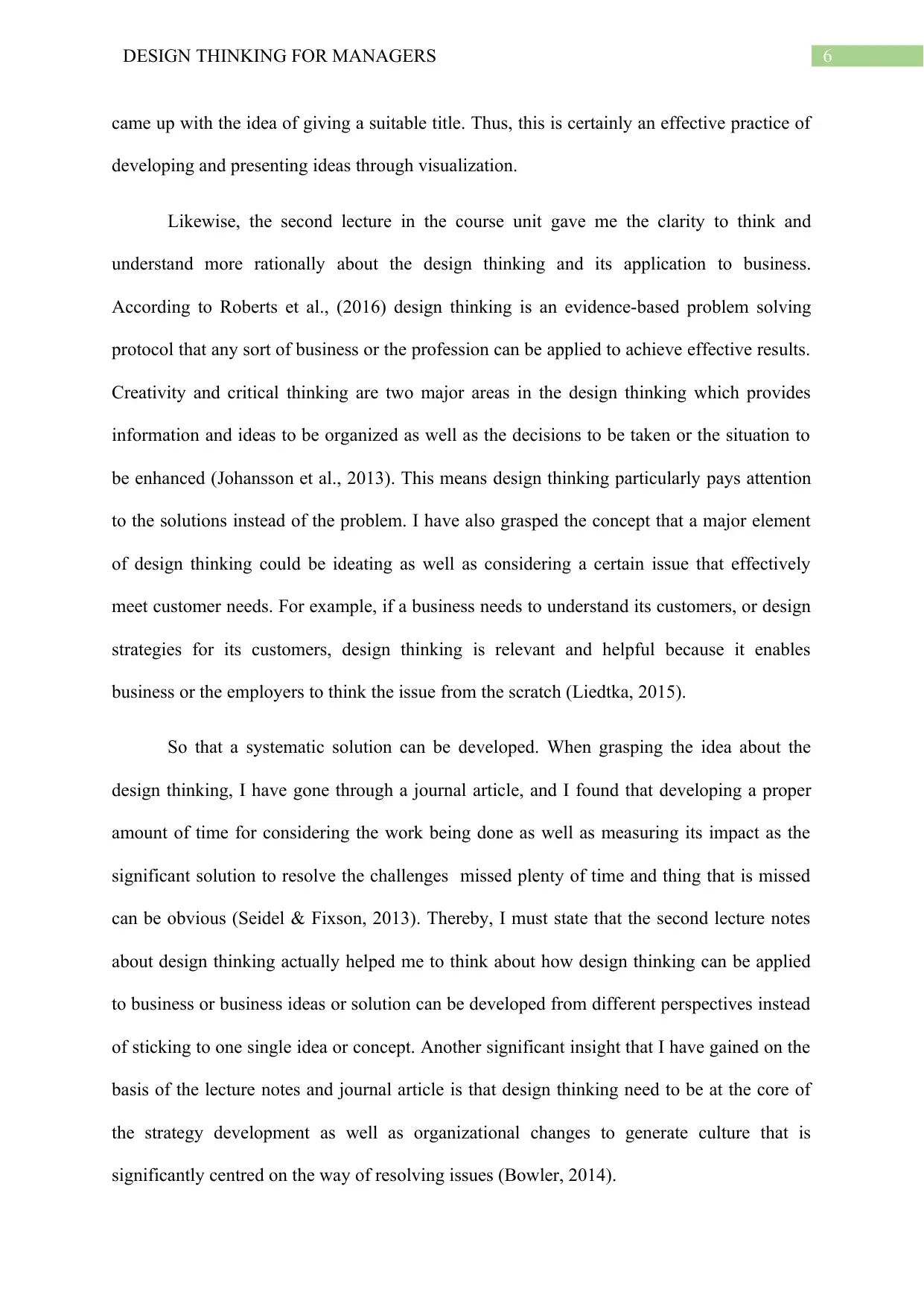
6DESIGN THINKING FOR MANAGERS
came up with the idea of giving a suitable title. Thus, this is certainly an effective practice of
developing and presenting ideas through visualization.
Likewise, the second lecture in the course unit gave me the clarity to think and
understand more rationally about the design thinking and its application to business.
According to Roberts et al., (2016) design thinking is an evidence-based problem solving
protocol that any sort of business or the profession can be applied to achieve effective results.
Creativity and critical thinking are two major areas in the design thinking which provides
information and ideas to be organized as well as the decisions to be taken or the situation to
be enhanced (Johansson et al., 2013). This means design thinking particularly pays attention
to the solutions instead of the problem. I have also grasped the concept that a major element
of design thinking could be ideating as well as considering a certain issue that effectively
meet customer needs. For example, if a business needs to understand its customers, or design
strategies for its customers, design thinking is relevant and helpful because it enables
business or the employers to think the issue from the scratch (Liedtka, 2015).
So that a systematic solution can be developed. When grasping the idea about the
design thinking, I have gone through a journal article, and I found that developing a proper
amount of time for considering the work being done as well as measuring its impact as the
significant solution to resolve the challenges missed plenty of time and thing that is missed
can be obvious (Seidel & Fixson, 2013). Thereby, I must state that the second lecture notes
about design thinking actually helped me to think about how design thinking can be applied
to business or business ideas or solution can be developed from different perspectives instead
of sticking to one single idea or concept. Another significant insight that I have gained on the
basis of the lecture notes and journal article is that design thinking need to be at the core of
the strategy development as well as organizational changes to generate culture that is
significantly centred on the way of resolving issues (Bowler, 2014).
came up with the idea of giving a suitable title. Thus, this is certainly an effective practice of
developing and presenting ideas through visualization.
Likewise, the second lecture in the course unit gave me the clarity to think and
understand more rationally about the design thinking and its application to business.
According to Roberts et al., (2016) design thinking is an evidence-based problem solving
protocol that any sort of business or the profession can be applied to achieve effective results.
Creativity and critical thinking are two major areas in the design thinking which provides
information and ideas to be organized as well as the decisions to be taken or the situation to
be enhanced (Johansson et al., 2013). This means design thinking particularly pays attention
to the solutions instead of the problem. I have also grasped the concept that a major element
of design thinking could be ideating as well as considering a certain issue that effectively
meet customer needs. For example, if a business needs to understand its customers, or design
strategies for its customers, design thinking is relevant and helpful because it enables
business or the employers to think the issue from the scratch (Liedtka, 2015).
So that a systematic solution can be developed. When grasping the idea about the
design thinking, I have gone through a journal article, and I found that developing a proper
amount of time for considering the work being done as well as measuring its impact as the
significant solution to resolve the challenges missed plenty of time and thing that is missed
can be obvious (Seidel & Fixson, 2013). Thereby, I must state that the second lecture notes
about design thinking actually helped me to think about how design thinking can be applied
to business or business ideas or solution can be developed from different perspectives instead
of sticking to one single idea or concept. Another significant insight that I have gained on the
basis of the lecture notes and journal article is that design thinking need to be at the core of
the strategy development as well as organizational changes to generate culture that is
significantly centred on the way of resolving issues (Bowler, 2014).
⊘ This is a preview!⊘
Do you want full access?
Subscribe today to unlock all pages.

Trusted by 1+ million students worldwide
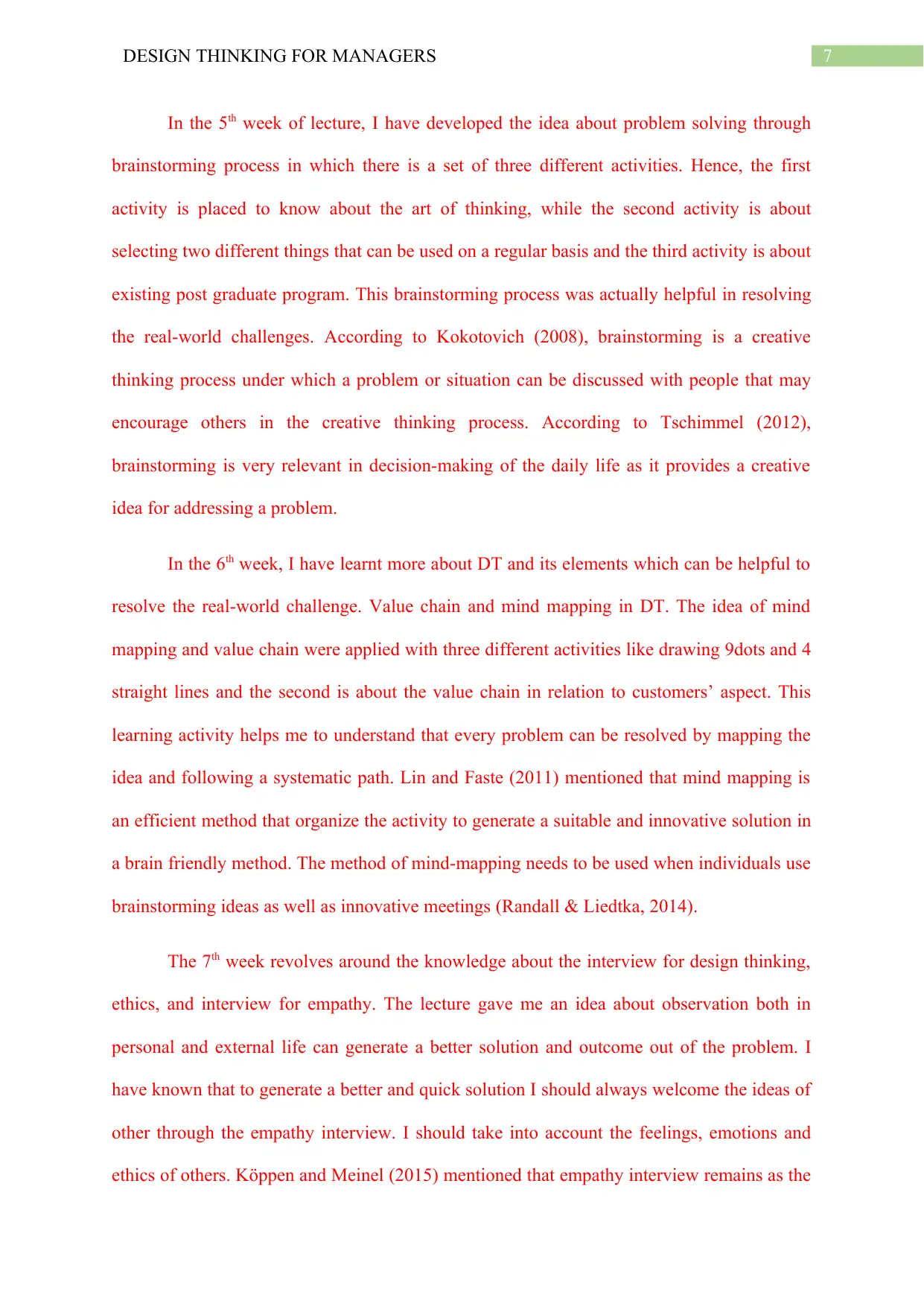
7DESIGN THINKING FOR MANAGERS
In the 5th week of lecture, I have developed the idea about problem solving through
brainstorming process in which there is a set of three different activities. Hence, the first
activity is placed to know about the art of thinking, while the second activity is about
selecting two different things that can be used on a regular basis and the third activity is about
existing post graduate program. This brainstorming process was actually helpful in resolving
the real-world challenges. According to Kokotovich (2008), brainstorming is a creative
thinking process under which a problem or situation can be discussed with people that may
encourage others in the creative thinking process. According to Tschimmel (2012),
brainstorming is very relevant in decision-making of the daily life as it provides a creative
idea for addressing a problem.
In the 6th week, I have learnt more about DT and its elements which can be helpful to
resolve the real-world challenge. Value chain and mind mapping in DT. The idea of mind
mapping and value chain were applied with three different activities like drawing 9dots and 4
straight lines and the second is about the value chain in relation to customers’ aspect. This
learning activity helps me to understand that every problem can be resolved by mapping the
idea and following a systematic path. Lin and Faste (2011) mentioned that mind mapping is
an efficient method that organize the activity to generate a suitable and innovative solution in
a brain friendly method. The method of mind-mapping needs to be used when individuals use
brainstorming ideas as well as innovative meetings (Randall & Liedtka, 2014).
The 7th week revolves around the knowledge about the interview for design thinking,
ethics, and interview for empathy. The lecture gave me an idea about observation both in
personal and external life can generate a better solution and outcome out of the problem. I
have known that to generate a better and quick solution I should always welcome the ideas of
other through the empathy interview. I should take into account the feelings, emotions and
ethics of others. Köppen and Meinel (2015) mentioned that empathy interview remains as the
In the 5th week of lecture, I have developed the idea about problem solving through
brainstorming process in which there is a set of three different activities. Hence, the first
activity is placed to know about the art of thinking, while the second activity is about
selecting two different things that can be used on a regular basis and the third activity is about
existing post graduate program. This brainstorming process was actually helpful in resolving
the real-world challenges. According to Kokotovich (2008), brainstorming is a creative
thinking process under which a problem or situation can be discussed with people that may
encourage others in the creative thinking process. According to Tschimmel (2012),
brainstorming is very relevant in decision-making of the daily life as it provides a creative
idea for addressing a problem.
In the 6th week, I have learnt more about DT and its elements which can be helpful to
resolve the real-world challenge. Value chain and mind mapping in DT. The idea of mind
mapping and value chain were applied with three different activities like drawing 9dots and 4
straight lines and the second is about the value chain in relation to customers’ aspect. This
learning activity helps me to understand that every problem can be resolved by mapping the
idea and following a systematic path. Lin and Faste (2011) mentioned that mind mapping is
an efficient method that organize the activity to generate a suitable and innovative solution in
a brain friendly method. The method of mind-mapping needs to be used when individuals use
brainstorming ideas as well as innovative meetings (Randall & Liedtka, 2014).
The 7th week revolves around the knowledge about the interview for design thinking,
ethics, and interview for empathy. The lecture gave me an idea about observation both in
personal and external life can generate a better solution and outcome out of the problem. I
have known that to generate a better and quick solution I should always welcome the ideas of
other through the empathy interview. I should take into account the feelings, emotions and
ethics of others. Köppen and Meinel (2015) mentioned that empathy interview remains as the
Paraphrase This Document
Need a fresh take? Get an instant paraphrase of this document with our AI Paraphraser
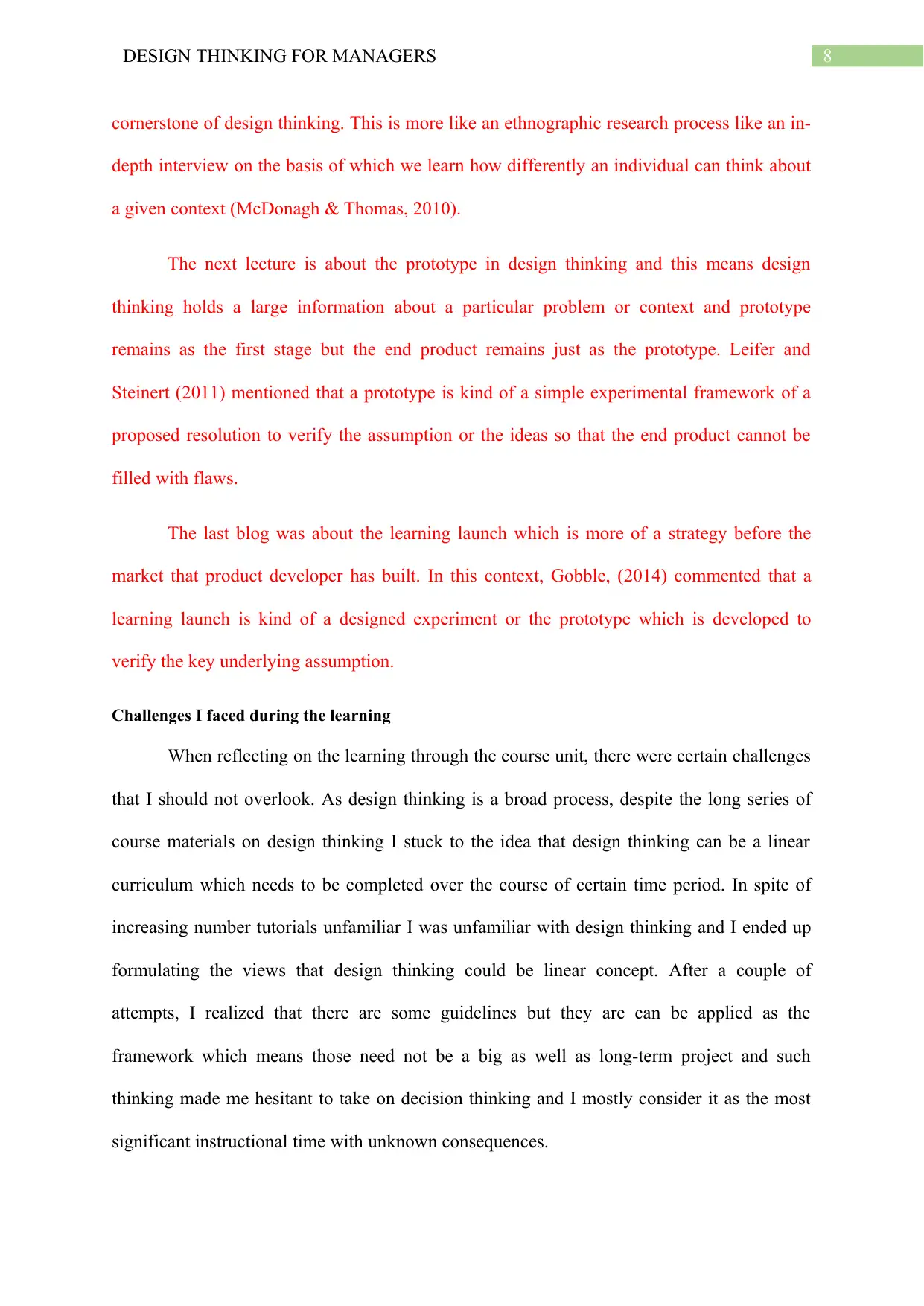
8DESIGN THINKING FOR MANAGERS
cornerstone of design thinking. This is more like an ethnographic research process like an in-
depth interview on the basis of which we learn how differently an individual can think about
a given context (McDonagh & Thomas, 2010).
The next lecture is about the prototype in design thinking and this means design
thinking holds a large information about a particular problem or context and prototype
remains as the first stage but the end product remains just as the prototype. Leifer and
Steinert (2011) mentioned that a prototype is kind of a simple experimental framework of a
proposed resolution to verify the assumption or the ideas so that the end product cannot be
filled with flaws.
The last blog was about the learning launch which is more of a strategy before the
market that product developer has built. In this context, Gobble, (2014) commented that a
learning launch is kind of a designed experiment or the prototype which is developed to
verify the key underlying assumption.
Challenges I faced during the learning
When reflecting on the learning through the course unit, there were certain challenges
that I should not overlook. As design thinking is a broad process, despite the long series of
course materials on design thinking I stuck to the idea that design thinking can be a linear
curriculum which needs to be completed over the course of certain time period. In spite of
increasing number tutorials unfamiliar I was unfamiliar with design thinking and I ended up
formulating the views that design thinking could be linear concept. After a couple of
attempts, I realized that there are some guidelines but they are can be applied as the
framework which means those need not be a big as well as long-term project and such
thinking made me hesitant to take on decision thinking and I mostly consider it as the most
significant instructional time with unknown consequences.
cornerstone of design thinking. This is more like an ethnographic research process like an in-
depth interview on the basis of which we learn how differently an individual can think about
a given context (McDonagh & Thomas, 2010).
The next lecture is about the prototype in design thinking and this means design
thinking holds a large information about a particular problem or context and prototype
remains as the first stage but the end product remains just as the prototype. Leifer and
Steinert (2011) mentioned that a prototype is kind of a simple experimental framework of a
proposed resolution to verify the assumption or the ideas so that the end product cannot be
filled with flaws.
The last blog was about the learning launch which is more of a strategy before the
market that product developer has built. In this context, Gobble, (2014) commented that a
learning launch is kind of a designed experiment or the prototype which is developed to
verify the key underlying assumption.
Challenges I faced during the learning
When reflecting on the learning through the course unit, there were certain challenges
that I should not overlook. As design thinking is a broad process, despite the long series of
course materials on design thinking I stuck to the idea that design thinking can be a linear
curriculum which needs to be completed over the course of certain time period. In spite of
increasing number tutorials unfamiliar I was unfamiliar with design thinking and I ended up
formulating the views that design thinking could be linear concept. After a couple of
attempts, I realized that there are some guidelines but they are can be applied as the
framework which means those need not be a big as well as long-term project and such
thinking made me hesitant to take on decision thinking and I mostly consider it as the most
significant instructional time with unknown consequences.
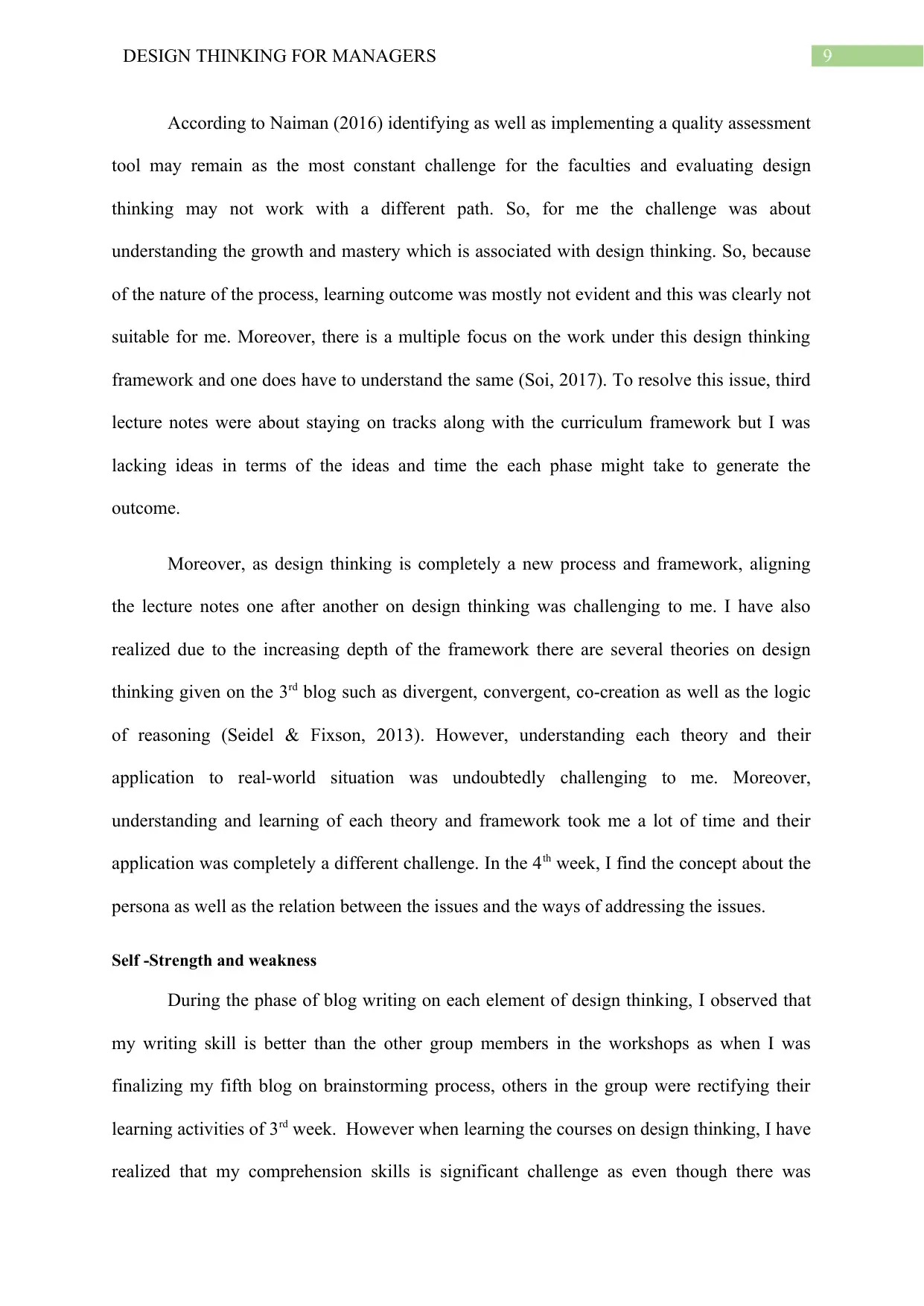
9DESIGN THINKING FOR MANAGERS
According to Naiman (2016) identifying as well as implementing a quality assessment
tool may remain as the most constant challenge for the faculties and evaluating design
thinking may not work with a different path. So, for me the challenge was about
understanding the growth and mastery which is associated with design thinking. So, because
of the nature of the process, learning outcome was mostly not evident and this was clearly not
suitable for me. Moreover, there is a multiple focus on the work under this design thinking
framework and one does have to understand the same (Soi, 2017). To resolve this issue, third
lecture notes were about staying on tracks along with the curriculum framework but I was
lacking ideas in terms of the ideas and time the each phase might take to generate the
outcome.
Moreover, as design thinking is completely a new process and framework, aligning
the lecture notes one after another on design thinking was challenging to me. I have also
realized due to the increasing depth of the framework there are several theories on design
thinking given on the 3rd blog such as divergent, convergent, co-creation as well as the logic
of reasoning (Seidel & Fixson, 2013). However, understanding each theory and their
application to real-world situation was undoubtedly challenging to me. Moreover,
understanding and learning of each theory and framework took me a lot of time and their
application was completely a different challenge. In the 4th week, I find the concept about the
persona as well as the relation between the issues and the ways of addressing the issues.
Self -Strength and weakness
During the phase of blog writing on each element of design thinking, I observed that
my writing skill is better than the other group members in the workshops as when I was
finalizing my fifth blog on brainstorming process, others in the group were rectifying their
learning activities of 3rd week. However when learning the courses on design thinking, I have
realized that my comprehension skills is significant challenge as even though there was
According to Naiman (2016) identifying as well as implementing a quality assessment
tool may remain as the most constant challenge for the faculties and evaluating design
thinking may not work with a different path. So, for me the challenge was about
understanding the growth and mastery which is associated with design thinking. So, because
of the nature of the process, learning outcome was mostly not evident and this was clearly not
suitable for me. Moreover, there is a multiple focus on the work under this design thinking
framework and one does have to understand the same (Soi, 2017). To resolve this issue, third
lecture notes were about staying on tracks along with the curriculum framework but I was
lacking ideas in terms of the ideas and time the each phase might take to generate the
outcome.
Moreover, as design thinking is completely a new process and framework, aligning
the lecture notes one after another on design thinking was challenging to me. I have also
realized due to the increasing depth of the framework there are several theories on design
thinking given on the 3rd blog such as divergent, convergent, co-creation as well as the logic
of reasoning (Seidel & Fixson, 2013). However, understanding each theory and their
application to real-world situation was undoubtedly challenging to me. Moreover,
understanding and learning of each theory and framework took me a lot of time and their
application was completely a different challenge. In the 4th week, I find the concept about the
persona as well as the relation between the issues and the ways of addressing the issues.
Self -Strength and weakness
During the phase of blog writing on each element of design thinking, I observed that
my writing skill is better than the other group members in the workshops as when I was
finalizing my fifth blog on brainstorming process, others in the group were rectifying their
learning activities of 3rd week. However when learning the courses on design thinking, I have
realized that my comprehension skills is significant challenge as even though there was
⊘ This is a preview!⊘
Do you want full access?
Subscribe today to unlock all pages.

Trusted by 1+ million students worldwide
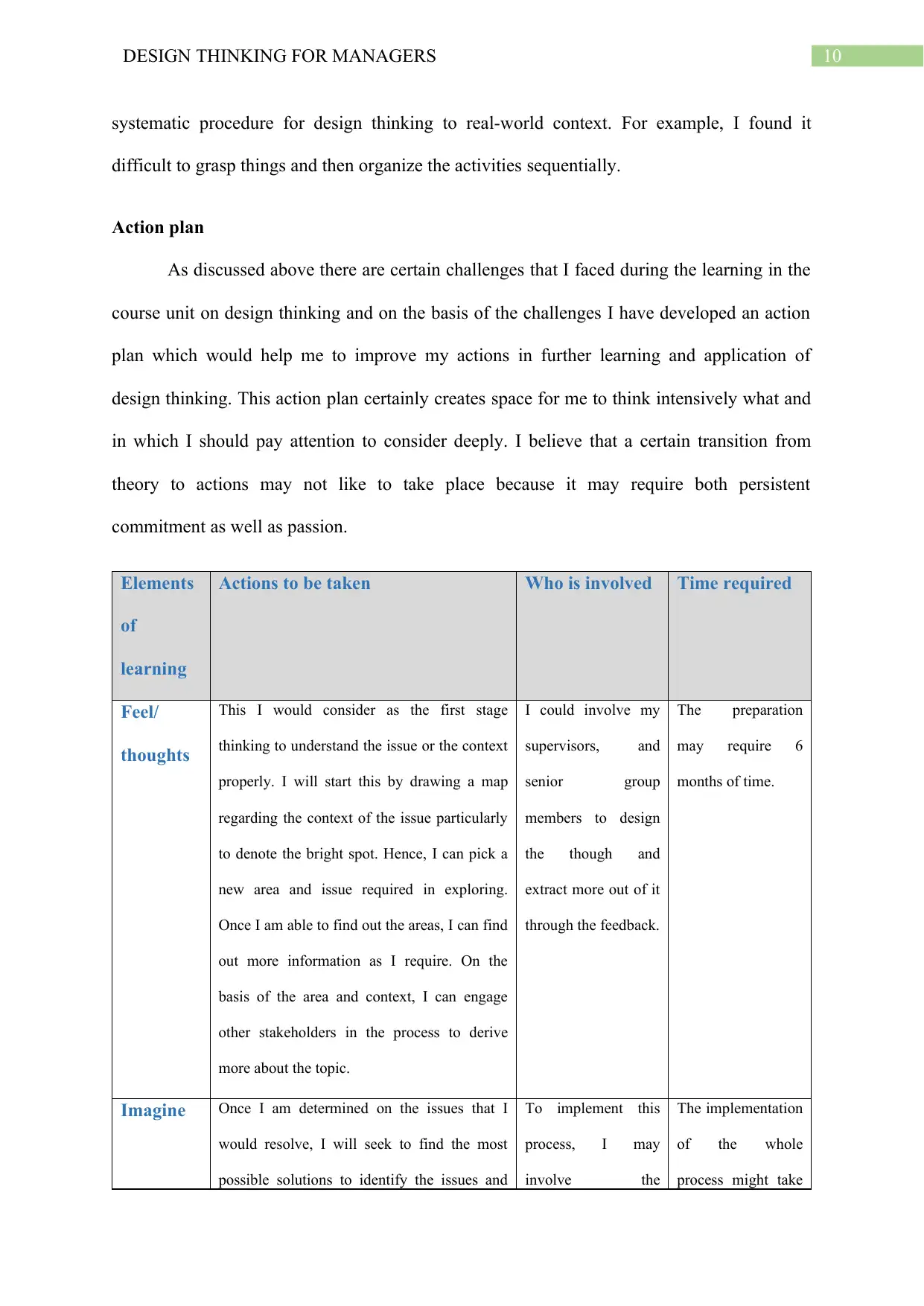
10DESIGN THINKING FOR MANAGERS
systematic procedure for design thinking to real-world context. For example, I found it
difficult to grasp things and then organize the activities sequentially.
Action plan
As discussed above there are certain challenges that I faced during the learning in the
course unit on design thinking and on the basis of the challenges I have developed an action
plan which would help me to improve my actions in further learning and application of
design thinking. This action plan certainly creates space for me to think intensively what and
in which I should pay attention to consider deeply. I believe that a certain transition from
theory to actions may not like to take place because it may require both persistent
commitment as well as passion.
Elements
of
learning
Actions to be taken Who is involved Time required
Feel/
thoughts
This I would consider as the first stage
thinking to understand the issue or the context
properly. I will start this by drawing a map
regarding the context of the issue particularly
to denote the bright spot. Hence, I can pick a
new area and issue required in exploring.
Once I am able to find out the areas, I can find
out more information as I require. On the
basis of the area and context, I can engage
other stakeholders in the process to derive
more about the topic.
I could involve my
supervisors, and
senior group
members to design
the though and
extract more out of it
through the feedback.
The preparation
may require 6
months of time.
Imagine Once I am determined on the issues that I
would resolve, I will seek to find the most
possible solutions to identify the issues and
To implement this
process, I may
involve the
The implementation
of the whole
process might take
systematic procedure for design thinking to real-world context. For example, I found it
difficult to grasp things and then organize the activities sequentially.
Action plan
As discussed above there are certain challenges that I faced during the learning in the
course unit on design thinking and on the basis of the challenges I have developed an action
plan which would help me to improve my actions in further learning and application of
design thinking. This action plan certainly creates space for me to think intensively what and
in which I should pay attention to consider deeply. I believe that a certain transition from
theory to actions may not like to take place because it may require both persistent
commitment as well as passion.
Elements
of
learning
Actions to be taken Who is involved Time required
Feel/
thoughts
This I would consider as the first stage
thinking to understand the issue or the context
properly. I will start this by drawing a map
regarding the context of the issue particularly
to denote the bright spot. Hence, I can pick a
new area and issue required in exploring.
Once I am able to find out the areas, I can find
out more information as I require. On the
basis of the area and context, I can engage
other stakeholders in the process to derive
more about the topic.
I could involve my
supervisors, and
senior group
members to design
the though and
extract more out of it
through the feedback.
The preparation
may require 6
months of time.
Imagine Once I am determined on the issues that I
would resolve, I will seek to find the most
possible solutions to identify the issues and
To implement this
process, I may
involve the
The implementation
of the whole
process might take
Paraphrase This Document
Need a fresh take? Get an instant paraphrase of this document with our AI Paraphraser
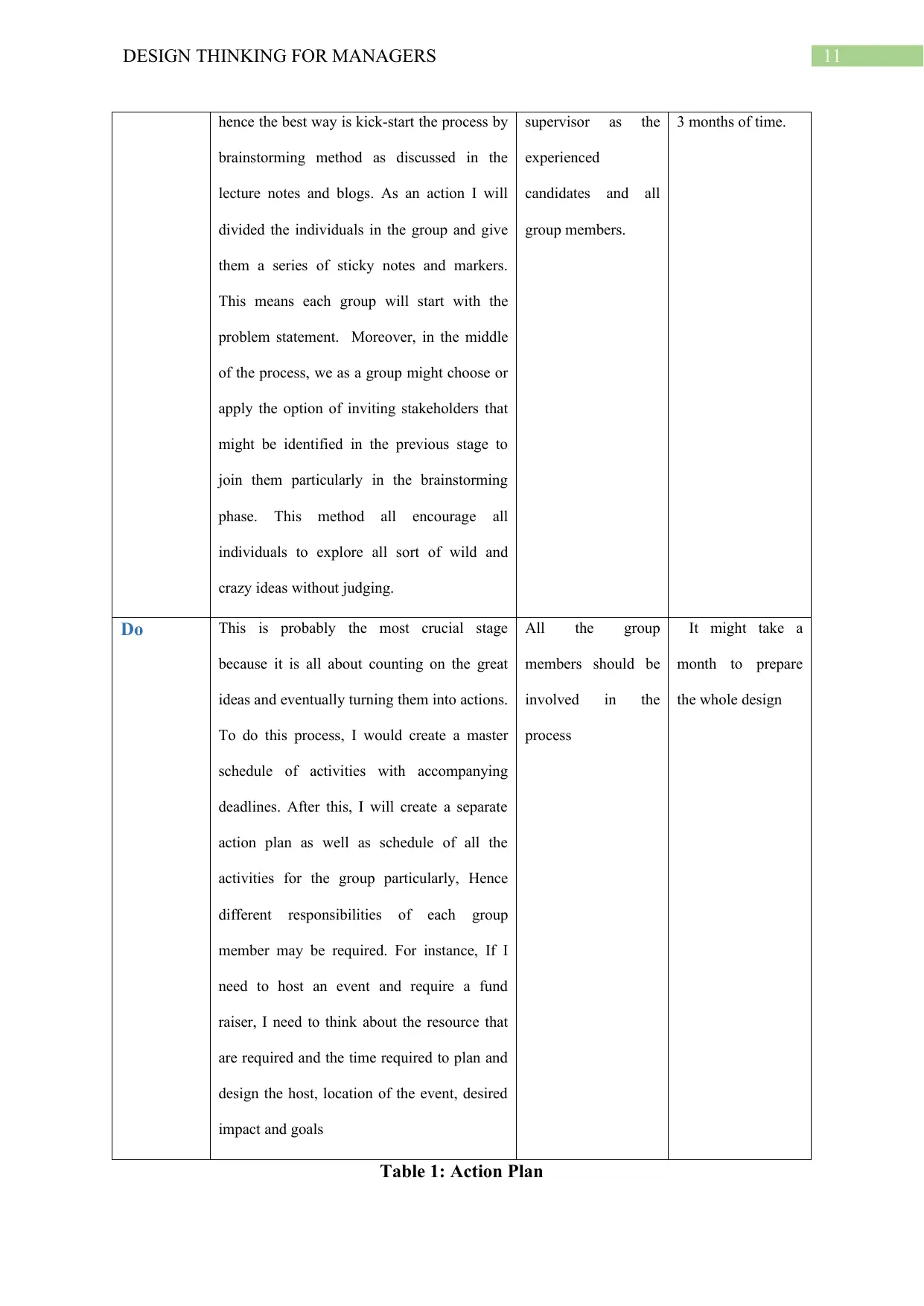
11DESIGN THINKING FOR MANAGERS
hence the best way is kick-start the process by
brainstorming method as discussed in the
lecture notes and blogs. As an action I will
divided the individuals in the group and give
them a series of sticky notes and markers.
This means each group will start with the
problem statement. Moreover, in the middle
of the process, we as a group might choose or
apply the option of inviting stakeholders that
might be identified in the previous stage to
join them particularly in the brainstorming
phase. This method all encourage all
individuals to explore all sort of wild and
crazy ideas without judging.
supervisor as the
experienced
candidates and all
group members.
3 months of time.
Do This is probably the most crucial stage
because it is all about counting on the great
ideas and eventually turning them into actions.
To do this process, I would create a master
schedule of activities with accompanying
deadlines. After this, I will create a separate
action plan as well as schedule of all the
activities for the group particularly, Hence
different responsibilities of each group
member may be required. For instance, If I
need to host an event and require a fund
raiser, I need to think about the resource that
are required and the time required to plan and
design the host, location of the event, desired
impact and goals
All the group
members should be
involved in the
process
It might take a
month to prepare
the whole design
Table 1: Action Plan
hence the best way is kick-start the process by
brainstorming method as discussed in the
lecture notes and blogs. As an action I will
divided the individuals in the group and give
them a series of sticky notes and markers.
This means each group will start with the
problem statement. Moreover, in the middle
of the process, we as a group might choose or
apply the option of inviting stakeholders that
might be identified in the previous stage to
join them particularly in the brainstorming
phase. This method all encourage all
individuals to explore all sort of wild and
crazy ideas without judging.
supervisor as the
experienced
candidates and all
group members.
3 months of time.
Do This is probably the most crucial stage
because it is all about counting on the great
ideas and eventually turning them into actions.
To do this process, I would create a master
schedule of activities with accompanying
deadlines. After this, I will create a separate
action plan as well as schedule of all the
activities for the group particularly, Hence
different responsibilities of each group
member may be required. For instance, If I
need to host an event and require a fund
raiser, I need to think about the resource that
are required and the time required to plan and
design the host, location of the event, desired
impact and goals
All the group
members should be
involved in the
process
It might take a
month to prepare
the whole design
Table 1: Action Plan
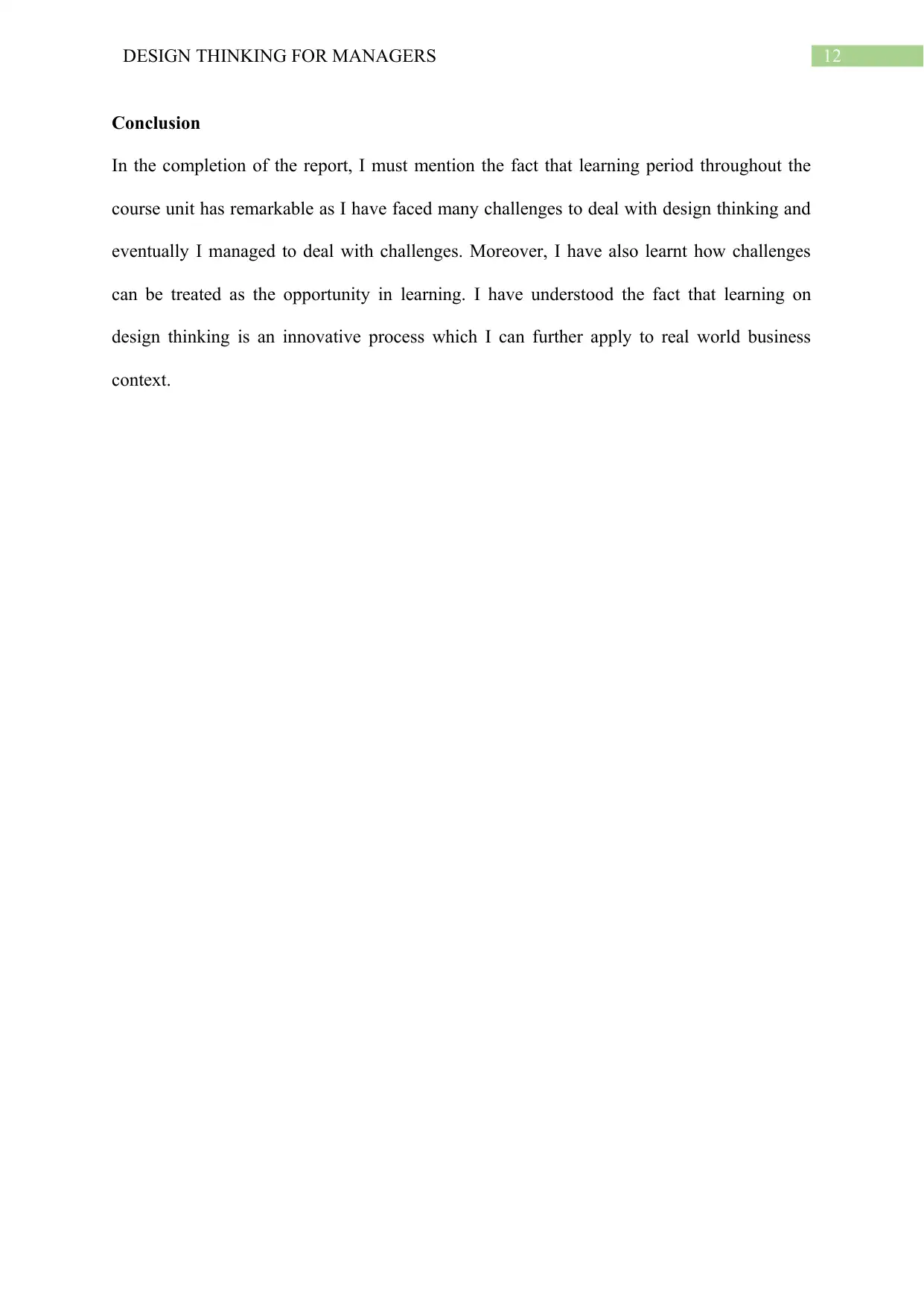
12DESIGN THINKING FOR MANAGERS
Conclusion
In the completion of the report, I must mention the fact that learning period throughout the
course unit has remarkable as I have faced many challenges to deal with design thinking and
eventually I managed to deal with challenges. Moreover, I have also learnt how challenges
can be treated as the opportunity in learning. I have understood the fact that learning on
design thinking is an innovative process which I can further apply to real world business
context.
Conclusion
In the completion of the report, I must mention the fact that learning period throughout the
course unit has remarkable as I have faced many challenges to deal with design thinking and
eventually I managed to deal with challenges. Moreover, I have also learnt how challenges
can be treated as the opportunity in learning. I have understood the fact that learning on
design thinking is an innovative process which I can further apply to real world business
context.
⊘ This is a preview!⊘
Do you want full access?
Subscribe today to unlock all pages.

Trusted by 1+ million students worldwide
1 out of 15
Related Documents
Your All-in-One AI-Powered Toolkit for Academic Success.
+13062052269
info@desklib.com
Available 24*7 on WhatsApp / Email
![[object Object]](/_next/static/media/star-bottom.7253800d.svg)
Unlock your academic potential
Copyright © 2020–2025 A2Z Services. All Rights Reserved. Developed and managed by ZUCOL.





